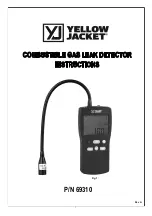
204 • Appendix G: Infrared Sensors
GX-6000 Operator’s Manual
IR Calibration
1 . See “Calibrating Using the Auto Calibration Method” on page 71 or “Calibrating
Using the Single Calibration Method” on page 82 for instructions to perform a
calibration.
NOTE:
If you are using the IR HC or IR CH
4
sensors in their autoranging
configuration, be sure to calibrate the range you’d like the most accuracy in
(either %LEL or %vol).
NOTE:
If there is a PID sensor installed in your instrument and you are calibrating an
IR CH
4
sensor with %vol concentrations, either calibrate the PID sensor first or
allow enough time for the %vol CH
4
gas to flush out before calibrating the PID
sensor.
IR Bump Testing
1 . See “Performing a Bump Test” on page 87 for instructions to perform a bump test.
Replacing an IR Sensor
When replacing a sensor, you may either replace it with another of the same sensor or you
may install a different IR sensor. If a different one is installed, the GX-6000 will load the
sensor parameters and configure the IR channel for the new sensor.
1 . Follow the instructions listed in “Replacing a Sensor” on page 113.
Be sure that the new sensor is installed in the same position as the old sensor and that the
following sensor priority for the smart sensor 1 position is maintained.
Table 26: Priority for Smart Sensor 1 Position
For example, if your instrument is a 4-gas + high range PID + IR HC, the high range PID
sensor should be in the smart sensor 1 position and the IR HC sensor should be in the
smart sensor 2 position. If your instrument is a 4-gas + IR HC, the IR HC sensor should be
in the smart sensor 1 position and a dummy sensor should be installed in the smart sensor
2 position. See the figure below for the location of the smart sensor 1 and 2 positions.
High Priority
Low Priority
10.6 eV low range PID
10.0 eV/benzene PID
11.7 eV PID
10.6 eV high range PID
ESS-03 Chlorine
ESS-03 Ammonia
IR and other ESS-03 sensors
















































